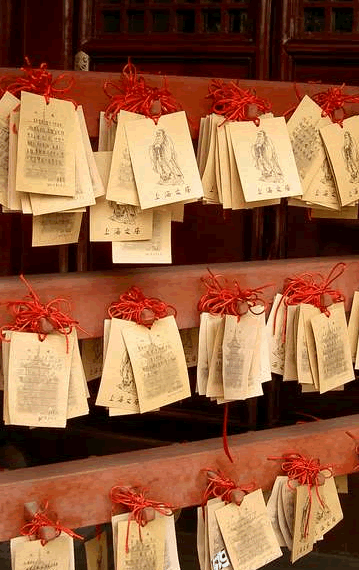Temples of the State Cult
OVERVIEW OF THE STATE CULT: ORGANIZATION AND PRACTICE*
The arrangement of state ritual below the emperor was coordinated exactly with the national administrative system. At each administrative level — province, prefecture, and county — there was a city or town serving as the administrative seat, where in addition to the government compound (yamen) which was the officiating magistrate’s headquarters, there were several official religious establishments: Among the most important were the Confucian or civil temple (wen miao), and the military temple (wu miao), which were the ritual foci of the two major divisions in the Chinese bureaucracy; and also the City God temple (chenghuang miao). A city serving as both prefectural seat and county seat would have two yamen and two sets of state temples.
In considering the State Cult, a question is whether emphasis should be on ritual or on religion — on the symbolic expression of those social and political values given emphasis in state ideology, or on the worship of the supernatural. For many Chinese thinkers in the Confucian tradition, there was a natural order linking humanity to the rest of the cosmos, which, as a totality, operated on moral principle. Humans are endowed with a nature that is good, and only selfish desires and passions place them in conflict with the (or their) natural order.
Confucius himself stressed the use of ritual and sacrifice as means to inculcate values of ethical and social importance for the living; rituals thus were used to encourage greater conformity to this natural order, rather than to express dependence on the supernatural. The arrangement of state ritual largely was compatible with such Confucian views; the focus of sacrifice and reverence was on natural forces or historical sages represented as inscribed tablets and not personified by images (which, in contrast, were the focus of Buddhist and Daoist temples). Whether these beliefs were “religious” has been a matter of some debate. However they may be characterized, these elite convictions did contrast with the beliefs in the supernatural held by the masses and indeed by many if not most officials and degree-holders.
CONFUCIAN TEMPLES
The Confucian temple housed a spirit tablet dedicated to Confucius himself, along with a collection of spirit tablets dedicated to various important scholars in the Confucian canon (many of these being Confucius’ own disciples; others would be eminent Confucian scholars from later times).
Rites at the Confucian temple were held by and for government officials of the district, as well as for the vastly larger number of degree-holders not in office. All the degree-holders of a district were required to attend the annual worship at the temple of Confucius on his birthday.
MILITARY TEMPLES
The military temple was the major temple for local people who had obtained degrees in the military examination system and were part of the military bureaucracy, which was subordinate to the civil bureaucracy. The military temple was devoted to the god of war, Guan Yu, and housed spirit tablets dedicated to Guan Yu as well as other figures who represented loyalty and patriotism, the two key values promoted in the military temples.
CITY GODS AND CITY GOD TEMPLES
Every major city had a City God (or Chenghuang Ye, “Lord of the Wall and Moat”) appointed by the imperial government, and by government statute every administrative seat had a City God temple. Popularly considered the living magistrate’s supernatural or divine counterpart, the City God was an important religious link between state and society.
The state encouraged the belief of most people that the City God occupied an important position in a pantheon of gods organized in a supernatural hierarchy paralleling that of the imperial government. A City God was usually considered to be the reincarnation of a human being who had been an official in earlier times.
The City God was thought to change every three years, just as a living magistrate would change office every three years. Both the magistrate and the god held sway over the same administrative area — the magistrate attending to this-worldly affairs and the City God to the supernatural. The magistrate, depending on one’s interpretation, either paid formal reverence to the City God or worshipped him, and was expected to appeal to the City God for supernatural assistance during droughts, floods, or other crises beyond direct human control. Among other duties the City God had the responsibility of dispatching the souls of the dead in his district to the Underworld realm.
Worship of the City God in Popular and Official Religion.** The City God cult represented a kind of symbolic meeting point between official religion and popular religion. Official worship of the deity involved solemn, dignified ceremonies in which only officials and degree holders could participate. These activities helped legitimize the state in the eyes of the common people and preserved local status distinctions. But popular worship of the City God had no such purpose and involved no such explicit distinctions. Individuals prayed to him for any and all kinds of favors (especially good health), and the ceremonies for the City God on his “birthday” and during his thrice-yearly tours of the city were among the largest, most impressive, and most widely observed public activities in traditional Chinese community life. On these occasions, the City God temple and its environs bustled with all kinds of activity: markets; theatrical performances; the selling of food; huge crowds; the noise of firecrackers, gongs, and drums; and the burning of incense. Most of these features were not to be found in the austere ritual of official religion.(1)
References
(1) See chapter by Stephen Feuchtwang in The City in Late Imperial China, ed. G. William Skinner (Stanford, 1977); and Angelo Zito, “City Gods, Filiality, and Hegemony in Late Imperial China,” Modern China 13:3 (1987).
